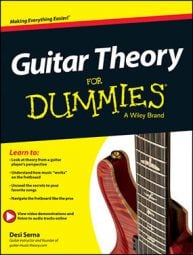The best way to start using the harmonic minor scale in a pentatonic pattern on the guitar is to play over a simple minor chord progression, using a minor pentatonic pattern and adding a raised 7th over the V7 chord. Start with A minor pentatonic and the chords Am and E7.
Here, you see A minor pentatonic followed by the same pattern with the raised 7th scale degrees of the harmonic minor shown in gray. Notice that this isn’t a full harmonic minor scale; it’s just a raised 7th added to the pentatonic.
![[Credit: Illustration courtesy of Desi Serna]](https://www.dummies.com/wp-content/uploads/417583.image0.jpg)
In music, the harmonic minor scale appears only for the V7 chord in a minor key progression. You use the natural minor scale over the other chords. For example, in progressions like Am-E7, Am-F-E7, and Am-G-F-E7, you only use the Gs of the harmonic minor scale over the E7 chord. For the remaining chords, a G-natural works better.
Check out “Smooth” by Santana for a great example of this technique. The song’s main progression is Am-F-E7, and Carlos Santana uses the A harmonic minor scale only over the E7 chord. He uses the pitches from A natural minor over the Am and F chords.
You can transpose this pentatonic pattern with the added raised 7th to other keys simply by moving it up and down the neck. Whatever key you choose to play in, use both the minor tonic chord and its V7 in your practice progressions. For example, use Em-B7 in the key of E minor, Gm-D7 in G minor, and Dm-A7 in D minor.
You can also try playing along with harmonic minor songs such as “Smooth” by Santana, “Nothing Else Matters” by Metallica, and “Sultans of Swing” by Dire Straits.

